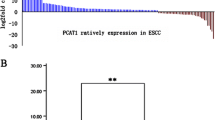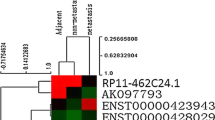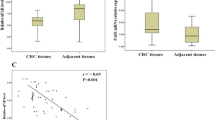Abstract
Long noncoding RNAs (lncRNA) are emerging as key molecules in human cancer. Prostate cancer–associated ncRNA transcripts 1 (PCAT-1), a lncRNA, has been recently revealed involving in human prostate cancer progression. However, whether PCAT-1 could serve as novel biomarker to predict prognosis in colorectal cancer (CRC) or not is unknown. We therefore carried out the present study to explore the correlation between PCAT-1 expression and the progression of CRC. In this study, the expression of PCAT-1 in 108 cases of CRC tissues and matched 81 adjacent normal tissues were determined by quantitative real-time PCR. Furthermore, the copy number variation of PCAT-1 was also measured in 17 tumor tissues and matched normal tissues. Our results showed that PCAT-1 expression in CRC tissues was significantly upregulated compared with the matched normal tissues (p < 0.001) and the overexpression of PCAT-1(upregulated by more than 50 %) was found in 64 % (62/81) of CRC. Moreover, PCAT-1 gene copy number variation explains only a few percent of observed overexpression. In addition, there was a significant association between PCAT-1 expression and distant metastasis (p = 0.04), but not other clinical characteristics. More important, CRC patients with PCAT-1 higher expression have shown significantly poorer overall survival than those with lower PCAT-1 expression (p < 0.001). Also, multivariable Cox regression analysis identified PCAT-1 overexpression as an independent prognostic factor for CRC (p = 0.007, HR = 3.12 95 %CI = 1.355–7.185). In conclusion, our results suggest that high expression of PCAT-1 is involved in CRC progression and could be a novel biomarker of poor prognosis in patient with colorectal cancer.



Similar content being viewed by others
References
Ottaiano A, Franco R, Aiello Talamanca A, Liguori G, Tatangelo F, Delrio P, Nasti G, Barletta E, Facchini G, Daniele B, et al. Overexpression of both CXC chemokine receptor 4 and vascular endothelial growth factor proteins predicts early distant relapse in stage II-III colorectal cancer patients. Clin Cancer Res. 2006;12(9):2795–803. doi:10.1158/1078-0432.CCR-05-2142.
Filipowicz W, Bhattacharyya SN, Sonenberg N. Mechanisms of post-transcriptional regulation by microRNAs: are the answers in sight? Nat Rev Genet. 2008;9(2):102–14. doi:10.1038/nrg2290.
Tzankov A, Gschwendtner A, Augustin F, Fiegl M, Obermann EC, Dirnhofer S, Went P. Diffuse large B-cell lymphoma with overexpression of cyclin e substantiates poor standard treatment response and inferior outcome. Clin Cancer Res. 2006;12(7 Pt 1):2125–32. doi:10.1158/1078-0432.CCR-05-2135.
Sotillo E, Thomas-Tikhonenko A. The long reach of noncoding RNAs. Nat Genet. 2011;43(7):616–7. doi:10.1038/ng.870.
Wilusz JE, Sunwoo H, Spector DL. Long noncoding RNAs: functional surprises from the RNA world. Genes Dev. 2009;23(13):1494–504. doi:10.1101/gad.1800909.
Guttman M, Donaghey J, Carey BW, Garber M, Grenier JK, Munson G, Young G, Lucas AB, Ach R, Bruhn L, et al. lincRNAs act in the circuitry controlling pluripotency and differentiation. Nature. 2011;477(7364):295–300. doi:10.1038/nature10398.
Lee JT. The X as model for RNA’s niche in epigenomic regulation. Cold Spring Harb Perspect Biol. 2010;2(9):a003749. doi:10.1101/cshperspect.a003749.
Huarte M, Guttman M, Feldser D, Garber M, Koziol MJ, Kenzelmann-Broz D, Khalil AM, Zuk O, Amit I, Rabani M, et al. A large intergenic noncoding RNA induced by p53 mediates global gene repression in the p53 response. Cell. 2010;142(3):409–19. doi:10.1016/j.cell.2010.06.040.
Nagano T, Fraser P. No-nonsense functions for long noncoding RNAs. Cell. 2011;145(2):178–81. doi:10.1016/j.cell.2011.03.014.
Prensner JR, Iyer MK, Balbin OA, Dhanasekaran SM, Cao Q, Brenner JC, Laxman B, Asangani IA, Grasso CS, Kominsky HD, et al. Transcriptome sequencing across a prostate cancer cohort identifies PCAT-1, an unannotated lincRNA implicated in disease progression. Nat Biotechnol. 2011;29(8):742–9. doi:10.1038/nbt.1914.
Lai MC, Yang Z, Zhou L, Zhu QQ, Xie HY, Zhang F, Wu LM, Chen LM, Zheng SS. Long non-coding RNA MALAT-1 overexpression predicts tumor recurrence of hepatocellular carcinoma after liver transplantation. Med Oncol. 2011. doi:10.1007/s12032-011-0004-z.
Braconi C, Kogure T, Valeri N, Huang N, Nuovo G, Costinean S, Negrini M, Miotto E, Croce CM, Patel T. microRNA-29 can regulate expression of the long non-coding RNA gene MEG3 in hepatocellular cancer. Oncogene. 2011. doi:10.1038/onc.2011.193.
Gupta RA, Shah N, Wang KC, Kim J, Horlings HM, Wong DJ, Tsai MC, Hung T, Argani P, Rinn JL, et al. Long non-coding RNA HOTAIR reprograms chromatin state to promote cancer metastasis. Nature. 2010;464(7291):1071–6. doi:10.1038/nature08975.
Huang JF, Guo YJ, Zhao CX, Yuan SX, Wang Y, Tang GN, Zhou WP, Sun SH. HBx-related lncRNA Dreh inhibits hepatocellular carcinoma metastasis by targeting the intermediate filament protein vimentin. Hepatology. 2012. doi:10.1002/hep.26195.
Siegel R, Naishadham D, Jemal A. Cancer statistics, 2012. CA Cancer J Clin. 2012;62(1):10–29. doi:10.3322/caac.20138.
Spizzo R, Almeida MI, Colombatti A, Calin GA. Long non-coding RNAs and cancer: a new frontier of translational research? Oncogene. 2012;31(43):4577–87. doi:10.1038/onc.2011.621.
Hughes S, Williams RD, Webb E, Houlston RS. Meta-analysis and pooled re-analysis of copy number changes in colorectal cancer detected by comparative genomic hybridization. Anticancer Res. 2006;26(5A):3439–44.
Saga Y, Mizukami H, Suzuki M, Kohno T, Urabe M, Ozawa K, Sato I. Overexpression of PTEN increases sensitivity to SN-38, an active metabolite of the topoisomerase I inhibitor irinotecan, in ovarian cancer cells. Clin Cancer Res. 2002;8(5):1248–52.
Hu YC, Lam KY, Law S, Wong J, Srivastava G. Identification of differentially expressed genes in esophageal squamous cell carcinoma (ESCC) by cDNA expression array: overexpression of Fra-1, Neogenin, Id-1, and CDC25B genes in ESCC. Clin Cancer Res. 2001;7(8):2213–21.
Aguilo F, Zhou MM, Walsh MJ. Long noncoding RNA, polycomb, and the ghosts haunting INK4b-ARF-INK4a expression. Cancer Res. 2011;71(16):5365–9. doi:10.1158/0008-5472.can-10-4379.
Benoit YD, Laursen KB, Witherspoon MS, Lipkin SM, Gudas LJ. Inhibition of PRC2 histone methyltransferase activity increases TRAIL-mediated apoptosis sensitivity in human colon cancer cells. J Cell Physiol. 2013;228(4):764–72. doi:10.1002/jcp.24224.
Fussbroich B, Wagener N, Macher-Goeppinger S, Benner A, Falth M, Sultmann H, Holzer A, Hoppe-Seyler K, Hoppe-Seyler F. EZH2 depletion blocks the proliferation of colon cancer cells. PLoS ONE. 2011;6(7):e21651. doi:10.1371/journal.pone.0021651.
Nie L, Wu HJ, Hsu JM, Chang SS, Labaff AM, Li CW, Wang Y, Hsu JL, Hung MC. Long non-coding RNAs: versatile master regulators of gene expression and crucial players in cancer. Am J Transl Res. 2012;4(2):127–50.
Prensner JR, Rubin MA, Wei JT, Chinnaiyan AM. Beyond PSA: the next generation of prostate cancer biomarkers. Sci Transl Med. 2012;4(127):127rv3. doi:10.1126/scitranslmed.3003180.
Salagierski M, Schalken JA. Molecular diagnosis of prostate cancer: PCA3 and TMPRSS2: ERG gene fusion. J Urol. 2012;187(3):795–801. doi:10.1016/j.juro.2011.10.133.
Yang Z, Zhou L, Wu LM, Lai MC, Xie HY, Zhang F, Zheng SS. Overexpression of long non-coding RNA HOTAIR predicts tumor recurrence in hepatocellular carcinoma patients following liver transplantation. Ann Surg Oncol. 2011;18(5):1243–50. doi:10.1245/s10434-011-1581-y.
Acknowledgments
This work was supported by the National Basic Research Program of China (2011CB504303), the Ministry of Science and Technology of China (2011ZX09307-001-04), and the Natural Science Foundation of Guangdong Province (9151008004000002). We thank Dr. Guoping shen for comments on previous versions of this manuscript.
Conflict of interest
The authors have no conflict of interest.
Author information
Authors and Affiliations
Corresponding author
Rights and permissions
About this article
Cite this article
Ge, X., Chen, Y., Liao, X. et al. Overexpression of long noncoding RNA PCAT-1 is a novel biomarker of poor prognosis in patients with colorectal cancer. Med Oncol 30, 588 (2013). https://doi.org/10.1007/s12032-013-0588-6
Received:
Accepted:
Published:
DOI: https://doi.org/10.1007/s12032-013-0588-6




